|
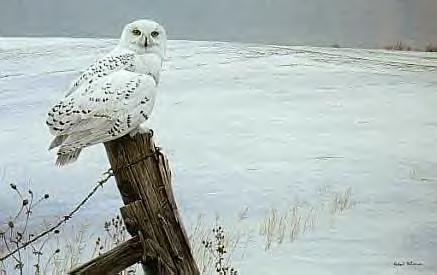 Some
other names for the Snowy Owl are Arctic Owl, Great White Owl, Ghost Owl,
Ermine Owl, Tundra Ghost, Ookpik, Scandinavian Nightbird, White Terror
of the North, and Highland Tundra Owl. It is the official bird of Quebec. Some
other names for the Snowy Owl are Arctic Owl, Great White Owl, Ghost Owl,
Ermine Owl, Tundra Ghost, Ookpik, Scandinavian Nightbird, White Terror
of the North, and Highland Tundra Owl. It is the official bird of Quebec.
Description:
The Snowy Owl is a large, diurnal white Owl that has a rounded head, yellow
eyes and black bill. The feet are heavily feathered. A distinctive white
Owl, their overall plumage is variably barred or speckled with thin, black,
horizontal bars or spots. Females and juveniles are more heavily marked
than males - adult males may be almost pure white, although they have
up to three tail bands. Adult females are distinctly barred throughout,
and have from four to six tail bands. Immatures are very heavily barred
throughout, and dark spotting may codominate or dominate the overall plumage.
Intensity of dark spotting varies with the sex of the immatures, females
being the darkest. Juveniles are uniformly brown with scattered white
tips of down.
Snowy
Owls have a direct, strong, and steady flight with deliberate, powerful
downstrokes and quick upstrokes. They make short flights, close to the
ground, from perch to perch, and usually perches on the ground or a low
post. During hot weather, they can thermoregulate by panting and spreading
their wings.
| Size:
|
|
|
average
female |
average
male |
| |
Length: |
51-68½cm
(20-27 inches) |
66cm (26 inches) |
59cm (23 inches) |
| |
Wingspan: |
137-164cm
(54-65 inches) |
|
|
| |
Weight: |
1134-2000g
(40-70oz) |
1707g
(60oz) |
1612g
(57oz) |
Voice:
The Snowy Owl is virtually silent during nonbreeding seasons. During the
breeding season males have a loud, booming "hoo, hoo" given
as a territorial advertisement or mating call.
Females
rarely hoot. Its attack call is a guttural "krufff-guh-guh-guk".
When excited it may emit a loud "hooo-uh, hooo-uh, hooo-uh, wuh-wuh-wuh".
Other sounds are dog-like barks, rattling cackles, shrieks, hissing, and
bill-snapping.
Nestlings
"cheep" up to 2 weeks of age, then hiss and squeal.
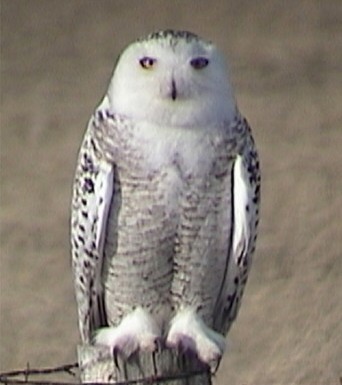 Hunting
& Food: Most hunting is done in the "sit and wait"
style, swivelling the head as much as 270 degrees scanning for prey. These
Owls are highly diurnal, although they may hunt at night as well. Prey
are captured on the ground, in the air, or snatched off the surface of
water bodies. Hunting
& Food: Most hunting is done in the "sit and wait"
style, swivelling the head as much as 270 degrees scanning for prey. These
Owls are highly diurnal, although they may hunt at night as well. Prey
are captured on the ground, in the air, or snatched off the surface of
water bodies.
When
taking snowshoe hares, a Snowy Owl will sink its talons into the back
and backflap until the hare is exhausted. The Owl will then breaks its
neck with its beak. Snowy Owls will often raid traplines for trapped animals
and bait, and will learn to follow traplines regularly. They also snatch
fish with their talons. Small prey up to small hares are swallowed whole,
while larger prey are carried away and torn into large chunks. Small young
are fed boneless and furless pieces. Large prey are carried of in the
Owl's talons, with prey like lemmings being carried in the beak.
Snowy
Owls are mainly dependent on lemmings and voles throughout most of their
Arctic and wintering range. When these prey are scarce they are an opportunistic
feeder and will take a wide range of small mammals and birds. Some mammal
prey include mice, hares, muskrats, marmots, squirrels, rabbits, prairie
dogs, rats, moles, and entrapped furbearers. Birds include ptarmigan,
ducks, geese, shorebirds, Ring-necked Pheasants, grouse, American coots,
grebes, gulls, songbirds, and Short-eared Owls. Snowy Owls will also take
fish and carrion.
Some
nesting Owls switch from lemmings and voles to young ptarmigan when they
become available. Snowy Owls do not hunt near their nests, so other birds,
such as Snow Geese, often nest nearby to take advantage of the Owls driving
off predators such as foxes.
Snowy
Owls produce large, rough-looking cylindrical pellets with numerous bones,
feathers, and fur showing. They are usually expelled at traditional roosting
sites and large numbers of pellets can be found in one spot. When large
prey are eaten in small pieces with little roughage, pellets will not
be produced.
Breeding:
Courtship behaviour can begin in midwinter through to March and April,
well away from breeding areas. Males will fly in undulating, moth-like
flight when females are visible. On the ground males will bow, fluff feathers,
and strut around with wings spread and dragging on the ground. Males kill
and display prey in caches to impress females, often feeding the female.
The Snowy Owl nests almost exclusively on the ground, where the female
makes a shallow scrape with her talons on top of an elevated rise, mound,
or boulder. Abandoned eagle nests and gravel bars are used occasionally.
Nests may be lined with scraps of vegetation and Owl feathers. Nest sites
must be near good hunting areas, be snow-free, and command a view of surroundings.
There is little breeding site-faithfulness between years or mates in some
areas, but in other areas, a pair of Owls may nest in the same spot for
several years. Territories around nests range from 1½ to 6½
square kilometres (0.6 to 2½ square miles), and overlap with other
pairs.
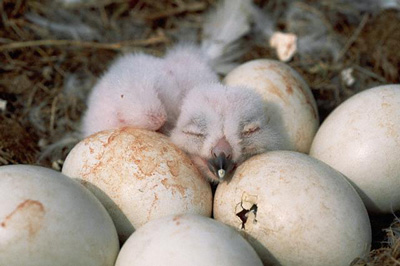 Breeding
occurs in May, Clutch and brood sizes are heavily dependent on food supply.
Snowy Owls may not nest at all during years of low lemming numbers. Clutch
sizes normally range from 5 to 8 white eggs but may be as many as 14 eggs
during high lemming years. They are laid at approximately 2 day intervals.
The female incubates while the male brings her food and guards the nest.
Eggs hatch in 32-34 days at two day intervals, leading to large age differences
in nests with large clutch sizes. Young are covered in white down. Young
begin to leave the nest after about 25 days, well before they can fly.
They are fledged at 50 to 60 days. Both parents feed and tend the young,
and are fiercely protective and may attack intruders up to 1 kilometre
(0.6 miles) from the nest! Nestling Owls require about 2 lemmings/day
and a family of Snowy Owls may eat as many as 1,500 lemmings before the
young disperse. Snowy Owls are single brooded and likely do not lay replacement
clutches if their first clutch is lost. Almost 100% nesting success can
be achieved during good vole years. Breeding
occurs in May, Clutch and brood sizes are heavily dependent on food supply.
Snowy Owls may not nest at all during years of low lemming numbers. Clutch
sizes normally range from 5 to 8 white eggs but may be as many as 14 eggs
during high lemming years. They are laid at approximately 2 day intervals.
The female incubates while the male brings her food and guards the nest.
Eggs hatch in 32-34 days at two day intervals, leading to large age differences
in nests with large clutch sizes. Young are covered in white down. Young
begin to leave the nest after about 25 days, well before they can fly.
They are fledged at 50 to 60 days. Both parents feed and tend the young,
and are fiercely protective and may attack intruders up to 1 kilometre
(0.6 miles) from the nest! Nestling Owls require about 2 lemmings/day
and a family of Snowy Owls may eat as many as 1,500 lemmings before the
young disperse. Snowy Owls are single brooded and likely do not lay replacement
clutches if their first clutch is lost. Almost 100% nesting success can
be achieved during good vole years.
Numbers
fluctuate wildly, usually in concert with lemming and vole numbers. For
Example, Banks Island may have 15,000 to 20,000 Snowy Owls during good
lemming years and only 2,000 during low lemming years with densities ranging
from 1 Owl per 2.6 square kilometre (1 Owl per square mile) in good lemming
years to 1 Owl per 26 square kilometres (1 Owl per 10 square miles) in
low lemming years.
Mortality:
Snowy Owls can live at least 9½ years in the wild and 35 years
in captivity. Natural enemies are few - Arctic foxes and wolves prey apon
them on their tundra breeding grounds, while skuas and jaegers may take
eggs or chicks.
 Habitat:
The Snowy Owl is a bird of Arctic tundra or open grasslands and fields.
They rarely venture into forested areas. During southward movements they
appear along lakeshores, marine coastlines, marshes, and even roost on
buildings in cities and towns. In the Arctic, they normally roost on pingaluks
(rises in the tundra) and breed from low valley floors up to mountain
slopes and plateaus over 1,000 meters (3,000 feet) in elevation. When
wintering in the Arctic, they frequent wind-swept tundra with little snow
or ice accumulation. At more southern latitudes they typically frequents
agricultural areas. Habitat:
The Snowy Owl is a bird of Arctic tundra or open grasslands and fields.
They rarely venture into forested areas. During southward movements they
appear along lakeshores, marine coastlines, marshes, and even roost on
buildings in cities and towns. In the Arctic, they normally roost on pingaluks
(rises in the tundra) and breed from low valley floors up to mountain
slopes and plateaus over 1,000 meters (3,000 feet) in elevation. When
wintering in the Arctic, they frequent wind-swept tundra with little snow
or ice accumulation. At more southern latitudes they typically frequents
agricultural areas.
Distribution:
Circumpolar - Arctic regions of the old and new worlds.
North America - Snowy Owls breed in the western Aleutian Islands, and
from northern Alaska, northern Yukon, and Prince Patrick and northern
Ellesmere islands south to coastal western Alaska, northern Mackenzie,
southern Keewatin, extreme northeastern Manitoba, Southampton and Belcher
islands, northern Quebec and northern Labrador. The Snowy Owl is highly
nomadic.
During
periods of lemming and vole population crashes in the Arctic, or excessive
cold and snow in winter, mass movements of Snowy Owls occur into southern
Canada and northern United States. These invasions occur every 3 to 5
years, but are highly irregular. Adult females stay furthest north while
immature males move furthest south during these incursions. In some years
small numbers may reach as far south as central California, southern Nevada,
Utah, Colorado, Oklahoma, central and southeastern Texas, the Gulf States
and Georgia.
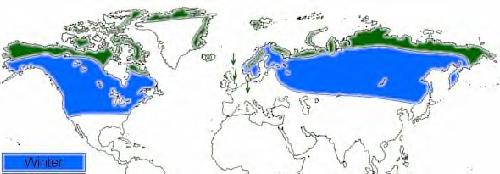
Snowy Owl distribution
(Dark Green - Summer Range, Blue - Winter Range)
|

 Believe
it or not, but in olden times the raven and the owl were both
white as snow.
Believe
it or not, but in olden times the raven and the owl were both
white as snow.  "Aren't
you tried of being so white, Owl? I know I am. Why don't we each
paint the other a different colour?"
"Aren't
you tried of being so white, Owl? I know I am. Why don't we each
paint the other a different colour?" He
scraped some of the burnt-out fat from a lamp, and, using that and
a large feather plucked out from his own tail, set to painting the
owl. He took great care doing it and drew gray spots of every size
on each feather, larger ones on the owl's wings and smaller ones
on her breast and back.
He
scraped some of the burnt-out fat from a lamp, and, using that and
a large feather plucked out from his own tail, set to painting the
owl. He took great care doing it and drew gray spots of every size
on each feather, larger ones on the owl's wings and smaller ones
on her breast and back.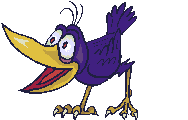 The
raven rubbed his eyes, and, seeing that he was now quite black all
over, cried:
The
raven rubbed his eyes, and, seeing that he was now quite black all
over, cried: Some
other names for the Snowy Owl are Arctic Owl, Great White Owl, Ghost Owl,
Ermine Owl, Tundra Ghost, Ookpik, Scandinavian Nightbird, White Terror
of the North, and Highland Tundra Owl. It is the official bird of Quebec.
Some
other names for the Snowy Owl are Arctic Owl, Great White Owl, Ghost Owl,
Ermine Owl, Tundra Ghost, Ookpik, Scandinavian Nightbird, White Terror
of the North, and Highland Tundra Owl. It is the official bird of Quebec. Hunting
& Food: Most hunting is done in the "sit and wait"
style, swivelling the head as much as 270 degrees scanning for prey. These
Owls are highly diurnal, although they may hunt at night as well. Prey
are captured on the ground, in the air, or snatched off the surface of
water bodies.
Hunting
& Food: Most hunting is done in the "sit and wait"
style, swivelling the head as much as 270 degrees scanning for prey. These
Owls are highly diurnal, although they may hunt at night as well. Prey
are captured on the ground, in the air, or snatched off the surface of
water bodies.  Breeding
occurs in May, Clutch and brood sizes are heavily dependent on food supply.
Snowy Owls may not nest at all during years of low lemming numbers. Clutch
sizes normally range from 5 to 8 white eggs but may be as many as 14 eggs
during high lemming years. They are laid at approximately 2 day intervals.
The female incubates while the male brings her food and guards the nest.
Eggs hatch in 32-34 days at two day intervals, leading to large age differences
in nests with large clutch sizes. Young are covered in white down. Young
begin to leave the nest after about 25 days, well before they can fly.
They are fledged at 50 to 60 days. Both parents feed and tend the young,
and are fiercely protective and may attack intruders up to 1 kilometre
(0.6 miles) from the nest! Nestling Owls require about 2 lemmings/day
and a family of Snowy Owls may eat as many as 1,500 lemmings before the
young disperse. Snowy Owls are single brooded and likely do not lay replacement
clutches if their first clutch is lost. Almost 100% nesting success can
be achieved during good vole years.
Breeding
occurs in May, Clutch and brood sizes are heavily dependent on food supply.
Snowy Owls may not nest at all during years of low lemming numbers. Clutch
sizes normally range from 5 to 8 white eggs but may be as many as 14 eggs
during high lemming years. They are laid at approximately 2 day intervals.
The female incubates while the male brings her food and guards the nest.
Eggs hatch in 32-34 days at two day intervals, leading to large age differences
in nests with large clutch sizes. Young are covered in white down. Young
begin to leave the nest after about 25 days, well before they can fly.
They are fledged at 50 to 60 days. Both parents feed and tend the young,
and are fiercely protective and may attack intruders up to 1 kilometre
(0.6 miles) from the nest! Nestling Owls require about 2 lemmings/day
and a family of Snowy Owls may eat as many as 1,500 lemmings before the
young disperse. Snowy Owls are single brooded and likely do not lay replacement
clutches if their first clutch is lost. Almost 100% nesting success can
be achieved during good vole years. Habitat:
The Snowy Owl is a bird of Arctic tundra or open grasslands and fields.
They rarely venture into forested areas. During southward movements they
appear along lakeshores, marine coastlines, marshes, and even roost on
buildings in cities and towns. In the Arctic, they normally roost on pingaluks
(rises in the tundra) and breed from low valley floors up to mountain
slopes and plateaus over 1,000 meters (3,000 feet) in elevation. When
wintering in the Arctic, they frequent wind-swept tundra with little snow
or ice accumulation. At more southern latitudes they typically frequents
agricultural areas.
Habitat:
The Snowy Owl is a bird of Arctic tundra or open grasslands and fields.
They rarely venture into forested areas. During southward movements they
appear along lakeshores, marine coastlines, marshes, and even roost on
buildings in cities and towns. In the Arctic, they normally roost on pingaluks
(rises in the tundra) and breed from low valley floors up to mountain
slopes and plateaus over 1,000 meters (3,000 feet) in elevation. When
wintering in the Arctic, they frequent wind-swept tundra with little snow
or ice accumulation. At more southern latitudes they typically frequents
agricultural areas.